<< Previous | Displaying results 2601-2650 of 6769 for "" | Next >>
A section of the prisoner barracks in the Majdanek camp. Photograph taken after the liberation of the camp in July 1944. Poland, date uncertain.
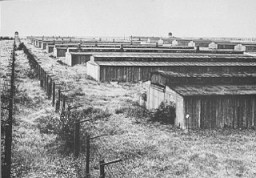
Main entrance to the Auschwitz-Birkenau killing center. This photograph was taken some time after the liberation of the camp in January 1945. Poland, date uncertain.
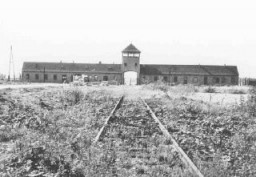
A crematorium at the Majdanek camp, outside Lublin. The photograph was taken after the Soviet liberation of Lublin/Majdanek in July 1944. Poland, date of photograph uncertain.
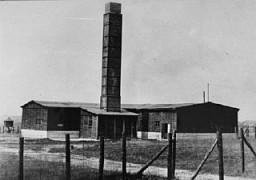
Zyklon B pellets found at the liberation of the Majdanek camp. Poland, after July 1944.

Humiliation of political prisoners: Social Democratic Party (SPD) inmates hold a placard which reads "I am a class-conscious person, party boss/SPD/party boss." Dachau concentration camp, Germany, between 1933 and 1936.

Romani (Gypsy) prisoners line up for roll call in the Dachau concentration camp. Germany, June 20, 1938.
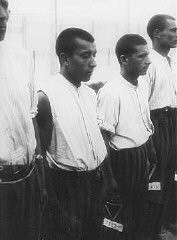
Romani (Gypsy) inmates stand at attention during an inspection of the weaving mill, site of forced labor in the Ravensbrück concentration camp. In this workshop prisoners wove reed mats used to reinforce roads in swampy regions of the eastern front. Germany, between 1941 and 1944. This photograph is from an SS propaganda album.
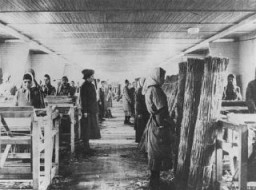
A Romani (Gypsy) victim of Nazi medical experiments to make seawater safe to drink. Dachau concentration camp, Germany, 1944.

Soviet prisoners of war in the Mauthausen concentration camp. Austria, January 1942.
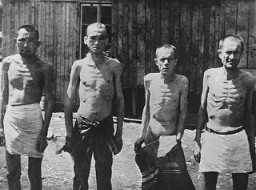
Column of Soviet prisoners of war from the eastern front. Kharkov, Soviet Union, June 18, 1942.

Bodies of Soviet prisoners of war who died in an unidentified camp. Place and date uncertain (after the German invasion of the Soviet Union).
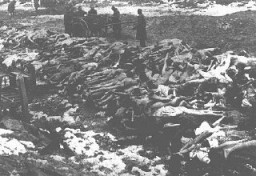
A victim of the Nazi Euthanasia Program. Hospitalized in a psychiatric ward for her nonconformist beliefs and writings, she was murdered on January 26, 1944. Germany, date uncertain.
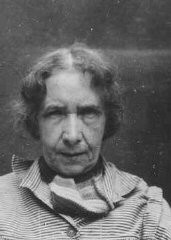
Photograph with the caption: "...because God cannot want the sick and ailing to reproduce." This image originates from a film, produced by the Reich Propaganda Ministry, that aimed through propaganda to develop public sympathy for the Nazi Euthanasia Program.
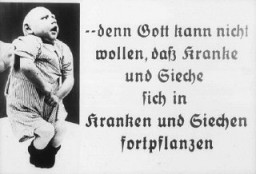
Emmi G., a 16-year-old housemaid diagnosed as schizophrenic. She was sterilized and sent to the Meseritz-Obrawalde euthanasia center where she was killed with an overdose of tranquilizers on December 7, 1942. Place and date uncertain.
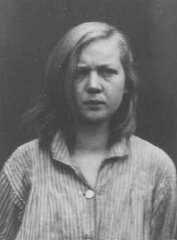
Helene Gotthold, a Jehovah's Witness, was beheaded for her religious beliefs on December 8, 1944, in Berlin. She is pictured with her children. Germany, June 25, 1936.

Waltraud Kusserow, a Jehovah's Witness, was arrested several times for refusing to make the "Heil Hitler" salute. She spent two and a half years in prison. Germany, after 1945.
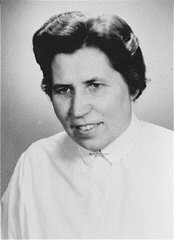
An official order incarcerating the accused in the Sachsenhausen concentration camp for the "offence" of homosexuality. Germany, July 1944. The Nazis posed as moral crusaders who wanted to stamp out what they labeled as the "vice" of homosexuality in order to help Germany win the racial struggle. They persecuted homosexuals as part of their so-called moral crusade to racially and culturally purify Germany.
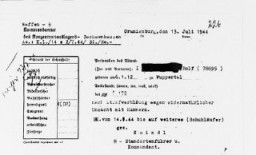
Portrait of Robert T. Odeman, author and actor who was imprisoned in 1937 for 27 months for homosexuality. In 1942, he was deported to Sachsenhausen concentration camp where he was a prisoner for three years. Berlin, Germany, before 1937.
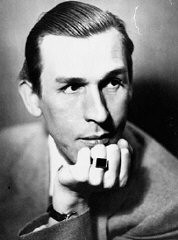
Interior designer from Duesseldorf who was charged with homosexuality and imprisoned for 18 months. Duesseldorf, Germany, date uncertain.
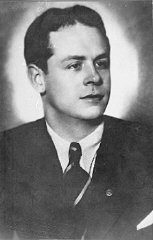
Dr. Fritz Klein stands among corpses in a mass grave at Bergen-Belsen, after the liberation of the camp. He was required to assist in the burial of inmates who died there. Klein was a camp doctor at both Auschwitz and Bergen-Belsen. Germany, after April 15, 1945.

Soviet officials view stacked corpses of victims at the Klooga camp. Due to the rapid advance of Soviet forces, the Germans did not have time to burn the corpses. Klooga, Estonia, 1944.
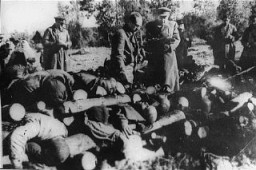
The valuables displayed here were confiscated from prisoners by German guards at the Buchenwald concentration camp and later found by soldiers of the Third US Army after the liberation of the camp. Buchenwald, Germany, after April 1945.
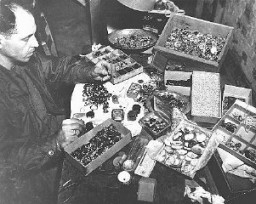
After the liberation of the Flossenbürg concentration camp, two US army infantrymen examine a pile of shoes belonging to victims of the camp. Flossenbürg, Germany, May 1945.

Generals Eisenhower, Patton, and Bradley view corpses of inmates at Ohrdruf, a subcamp of Buchenwald. Germany, April 12, 1945.
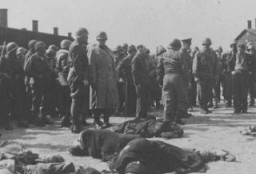
US troops land on Guadalcanal, in the Solomon Islands group. Guadalcanal was the focus of crucial battles in 1942–43. American victory in the Solomons halted the Japanese advance in the South Pacific. Guadalcanal, August 1942.
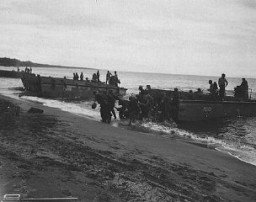
US troops land on Guadalcanal, in the Solomon Islands groups. Guadalcanal was the focus of crucial battles in 1942–43. American victory in the Solomons halted the Japanese advance in the South Pacific. Guadalcanal, date uncertain.
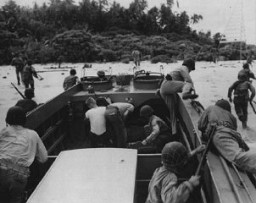
A US PT (Patrol Torpedo) boat off the coast of New Guinea, during an American counteroffensive against Japanese advances in the Solomon Islands in the eastern Pacific Ocean, 1943.
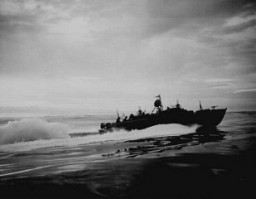
US Marines head for the front lines in the jungles of Bougainville, one of the Solomon Islands in the Pacific Ocean. 1943.
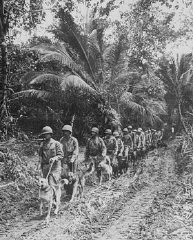
An amphibious troop carrier loaded with US Marines heads for the beaches of Tinian, an island in the Pacific Ocean. July 1944.
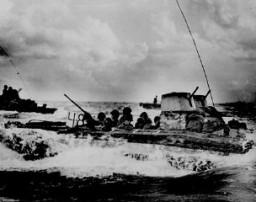
US Marines during the final stage of the fight for Peleliu Island in the Pacific theater of war. September 14, 1944.
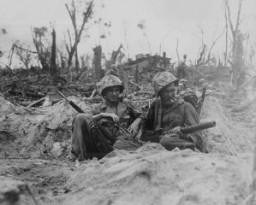
Supply ships reinforce US forces on the Philippine island of Leyte during the US invasion of the Philippines. 1944.
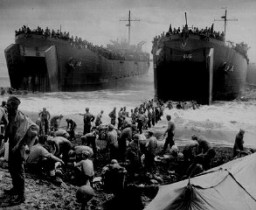
US sailors struggle to contain damage from Kamikaze attacks during the US invasion of Okinawa, the largest of the Ryukyu Islands (the islands closest to the Japanese home islands). May 11, 1945.
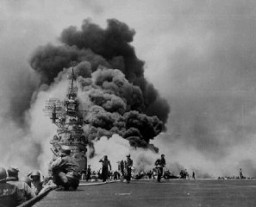
Nazi foreign minister Joachim von Ribbentrop (left), Soviet leader Joseph Stalin (center), and Soviet foreign minister Viacheslav Molotov (right) at the signing of the nonaggression pact between Germany and the Soviet Union. Moscow, Soviet Union, August 1939.
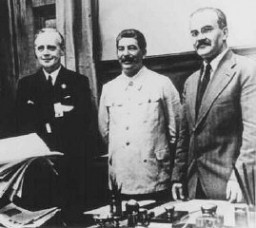
Soviet foreign minister Viacheslav Molotov signs the German-Soviet pact as Soviet leader Joseph Stalin (white uniform) and German foreign minister Joachim von Ribbentrop (behind Molotov) look on. Moscow, Soviet Union, August 23, 1939.
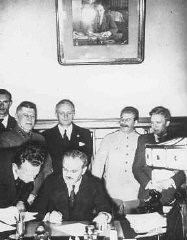
Two German sentries stand guard at Augustow on the demarcation line between Soviet- and German-occupied Poland. September 1939.
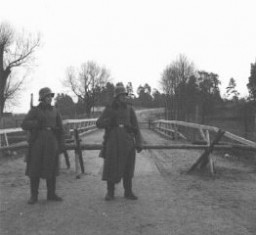
A post marked with Soviet symbols along the demarcation line between German- and Soviet-occupied Poland.
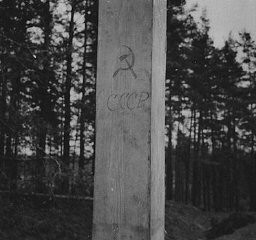
General Dwight D. Eisenhower visits with paratroopers of the 101st Airborne Division just hours before their jump into German-occupied France (D-Day). June 5, 1944.
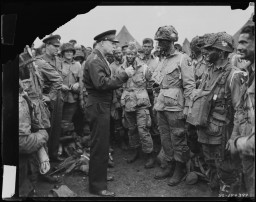
Assault troops in a landing craft approach Omaha Beach on D-Day. Normandy, France, June 6, 1944.
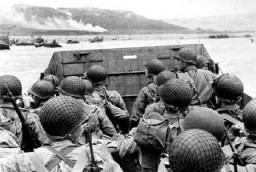
US troops wade through the surf on their arrival at the Normandy beaches on D-Day. Normandy, France, June 6, 1944.
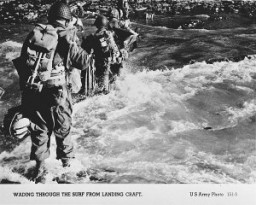
US troops pull the survivors of a sunken craft onto the shores of the Normandy beaches on D-Day. Normandy, France, June 6, 1944.
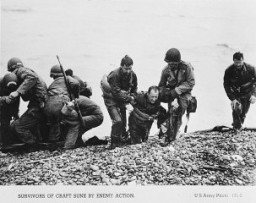
The Normandy beach as it appeared after D-Day. Landing craft on the beach unload troops and supplies transferred from transports offshore. Barrage balloons hover overhead to deter German aircraft. Normandy, France, undated (after June 6, 1944).
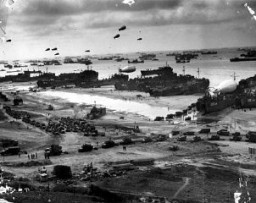
Teenager Simon Jeruchim learned of the Allied invasion of German-occupied France (D-Day) on a shortwave radio. He painted a watercolor depiction of the bombing and burning of a town situated on a river. He titled the piece "Memory of June 6, 1944." Simon Jeruchim was born in Paris in 1929 to Samuel and Sonia (née Szpiro), Jewish émigrés from Poland. In July 1942, Simon’s parents were able to find hiding places for him and his siblings, but they were arrested and deported to Auschwitz before they…
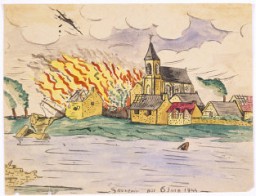
Graduates of the Piotrkow Trybunalski Hebrew Gymnasium (Jewish high school). Piotrkow Trybunalski, Poland, 1929.
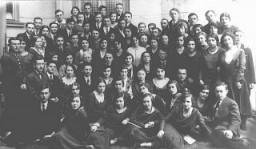
A first-grade class at a Jewish school. Cologne, Germany, 1929-1930.
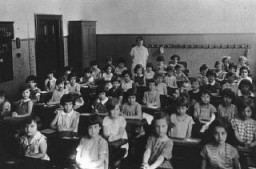
Three generations of a Jewish family pose for a group photograph. Vilna, 1938-39. The photo was taken during daughter Mina's visit from Montreal. Among those pictured are Mina (Katz) Herman and her daughter, Audrey (front row, second from the right), Itzik Katz, Mina's brother (standing at the far left) and Malka Katz, Mina's mother (front row, center).
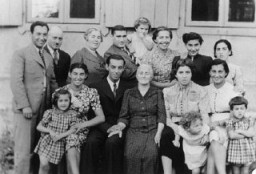
Jewish children gathered for a sporting event in a summer camp organized by the Reich Union of Jewish Frontline Soldiers. Germany, between 1934 and 1936.

Class photo of students and a teacher at a Jewish school in prewar Karlsruhe. Germany, July 1937.
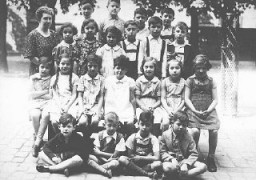
An American soldier looks at the corpses of Polish, Russian, and Hungarian Jews found in the woods near Neunburg vorm Wald. The victims were prisoners from Flossenbürg who were shot near Neunburg while on a death march. Germany, April 29, 1945.
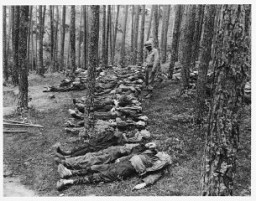
The bodies of Jewish women exhumed from a mass grave near Volary. The victims died at the end of a death march from Helmbrechts, a subcamp of Flossenbürg. Germans were forced to exhume them in order to give the victims proper burial. Volary, Czechoslovakia, May 11, 1945.
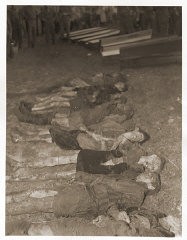
Under the supervision of American medics, German civilians file past the bodies of Jewish women exhumed from a mass grave in Volary. The victims died at the end of a death march from Helmbrechts, a subcamp of Flossenbürg. Germans were forced to exhume them in order to give the victims proper burial. Volary, Czechoslovakia, May 11, 1945.

We would like to thank Crown Family Philanthropies, Abe and Ida Cooper Foundation, the Claims Conference, EVZ, and BMF for supporting the ongoing work to create content and resources for the Holocaust Encyclopedia. View the list of donor acknowledgement.